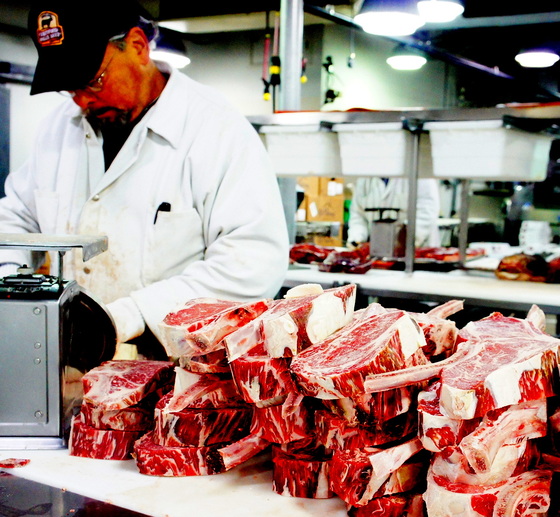 Top: Meatcutter Lenny Olsen processing bone-in rib-eye steaks. Above: Patrick Marshall with tray of steaks: filets, New York strips, bone-in ribeyes. Left: Smithco's Jay Keener, meatcutter Rick Fickle, ribeye steak; dry-aging room.
Top: Meatcutter Lenny Olsen processing bone-in rib-eye steaks. Above: Patrick Marshall with tray of steaks: filets, New York strips, bone-in ribeyes. Left: Smithco's Jay Keener, meatcutter Rick Fickle, ribeye steak; dry-aging room.
Just look at all this meat! This is all from an outfit called Smithco Meats, located in the sleepy, north Pierce County city of Sumner, populaton 10,000, where Sumner Chevrolet sales lots anchor the town's principal intersection and the high school's Sunset Stadium bears the Chevy logo. By the way, today (Friday,October 19th) is the Home Coming game for the Sumner Spartans.
A mile or so past the stadium stands a modest, one-story building without signage, home of Smithco Meats. "We don't sell retail, so we don't want to attract attention," says owner Jay Keener, who bought the company from the Smith family three years ago, after he "retired." He'd grown up as a "sawdust kid" in his own family's business, Keener's Meats in Bothell, that was bought out by increasingly anonymous national firms. Now he's happily back at work, running Smithco as a regional distributor specialized in delivery to restaurants.
The meat business is high volume, low margin. A company like Smithco buys what are called subprimal cuts, rather than, say, half a steer, and breaks them down, takes them apart, trims them, losing volume every step of the way. By the time they have, say, a tenderloin dry-aged and ready to deliver to a high-end steakhouse, it's worth $24 a pound.
Seventy percent of America's beef is sold in supermarkets and butcher shops where a piece of meat is priced according to its weight. In food service, on the other hand, you've got to provide what the restaurant asks for: a 10-ounce New York cut, for example, or a 12-ounce cut. The price is "per each," so Smithco's cutters place each piece on a scale after they trim it, to be sure it's up to spec. At $24 a pound, an almost-imperceptible deviation of half an ounce would quickly turn into financial disaster.
Cornichon was introduced to this world by Bradley Dickinson, co-owner with Mikel Rogers, of two high-energy restaurants in Bellevue: Pearl and Koral. Dickinson, who was the executive chef for Schwartz Brothers before setting out on his own three years ago, doesn't have the buying power of his competitors (two chains, Palomino and Maggiano's are in the same building), so he looks for opportunity to compete on quality and on local sourcing.
Everyone's afraid of what the corn shortage will do to livestock prices and availability. The nation's cattle herd is down by 1.5 million animals compared to last year, and the number of "placements" going into feed lots is declining. The flavor of a steak, Keener will tell you, comes from the animal's feed in the last three months of its life. "Grass-fed" beef may sound warm and fuzzy, but doesn't have the same rich taste. That means corn-fed beef, from the corn belt of the Midwest, although the potatoes, barley and soybeans of eastern Washington make a reasonable substitute. Still, Smithco's business model depends less on the price of what they buy than their ability to provide customized service to their customers. "It's about relationships," Keener says, and Dickinson agrees.


Mmmmm Meat! Great story!